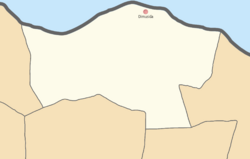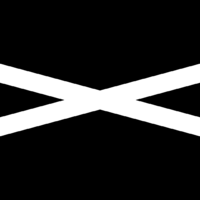Dimusida
Dimusida (Tagdamun: Dimusida, Cienugueza: Dimusida, Tsinsat: 不破市, IPA: /di.mu.'si.ra/), officially known as the Dimusida Metropolitan Area, is a metropolis in northern Qenuga that serves as the economic and cultural center of Amone state. It is the largest metropolis in Amone with almost 15 million inhabitants as of the 33rd century. The nearest areas to Dimusida are Lirios in the south, metro Lasamkapal in the west, and metro Nulgiak in the east. Dimusida consists of five cities: Bungindasay, Tikanliab, Misatsa, Sisintub, and Kamakni.
| Dimusida Dyantalum Dimusida (Tagdamun) 不破市 (Tsinsat) | ||
|---|---|---|
| Dimusida Metropolitan Area | ||
   From left to right, top to bottom: Skyline of Dimusida, Libas Apuy Bugya in Misatsa, and Dimusida's coastline in Bungindasay | ||
| ||
 Location of Dimusida in Amone | ||
| Country | Qenuga | |
| State |
| |
| City establishment | May 2, 2799; 736 years ago | |
| Partition | August 1, 3036; 499 years ago | |
| Government | ||
| • Type | Mayor-council government | |
| • Honorary mayor | Obreno Giadam | |
| • Honorary parliament member | Ginebra Permizo | |
| Demonym(s) | Tagdimusida | |
| Time zone | EQT (UTC+11) | |
| Area code(s) | 92 | |
Since the late 30th century, Dimusida transformed into an important economic and social hub locally and nationally. The city contains the regional and national headquarters of many important Chungganese companies, brought about by developments in its mining industry that attracted the attention of investors and Amonenos. Dimusida is also a key player in the tourism, food, and logistics industries. Its northern coast, under the juridsdiction of Bungindasay, hosts the Port of Dimusida, one of the busiest waterways in Qenuga, as well as vibrant tourism with resorts and beaches lining up the area. Dimusida continues to be an economic and political powerhouse in the 33rd century with its largest city Bungindasay being the capital of the whole Amone state.
Overview
Etymology
The name of Dimusida comes from the Tagdamun words dili ("not") and musida ("breakable"). In Tsinsat, the city's name rendered by the characters 不 and 破, respectively.
Flag
The flag of Dimusida is a black square with two white diagonal lines intersecting each other at the center. According to its designer, the flag carries many meanings, including the following:
- Railroad crossings portrayed by the letter X in the English language
- Symbol of rejection among Tagdimusida as the city experienced many moments of civil unrest
History
Lardekbot
Dimusida was the site former state Duyurod.
Tagdamun Revolution
During the Tagdamun Revolution, a large portion of the Duyurod settlement was regrouped into the state of Amone as part of an effort to revive the nation's social order after the fatal War of Colors that greatly affected many communities in the state. This move, however, did not immediately translate into economic development nor interstate attention even with the approximate location of the modern-day city being located within 30 km of the national R7 expressway. On May 2, 2799, the city of Dimusida was founded. The name, literally "unbreakable", referred to the still-standing structures after the war and the revolution. Throughout the following centuries, the Tagdimusida thrived simply with its fishing and foraging economy. Dimusida mostly relied on imports from its neighbor cities and Metro Punnayun.
28th and 29th centuries
In the middle 29th century, Dimusida became a center for entertainment and tourism, with many motion pictures, television series, and videos using the city as filming locations. Together with the increasing popularity of resorts and hotels along its shoreline brought about by Dimusida's widening presence in popular media, many Tagdimusida became employed in those industries. Before the end of the century, Dimusida's population increased by 72.2% (+200,000).
Mining industry boom
Several cities in Amone, such as Silingnitu and Lasamkapal, reported deposits of previously-undiscovered minerals in its respective surrounding areas in the early 2900s, during what is contemporarily called the Amone Boom. The creation of such mines was then considered an impressive feat given that most of Qenuga's metal supply dried out by the 25th century and industries using those minerals resorted to using artificial metals with similar properties. In line with the potential existence of such deposits in Dimusida, a metallurgical engineer from the city named Branno Hajoye established a geosurveying firm called Firewall in 2915, which aimed to survey Dimusida's surrounding land in the hopes of scoring mineral deposits and bolstering the city's backwater economy. By 2921, his company Firewall announced massive deposits of nickel, copper, iron, and various rare earth metals in the towns to its south. This prompted Firewall to set up mining towns in those southern towns and hire the locals as miners. Tagdimusida were also employed under the Firewall company, working under its logistics, manufacturing, and construction divisions. The metals and revenue generated by the company fuelled massive economic growth, spending, and population boom throughout the next three decades. As many as 70,000 people were employed by Firewall at its peak in 2940. In less than 50 years since Dimusida's Mining Boom, the city's population size quintupled from 504,000 to over 2.5 million.
Concerns over Firewall's aggressive mining practices grew little by little, with a think tank estimating that the supply of natural metals from Firewall's mines may be depleted by the start of the 3000s. This concern was most loudly voiced out by local conservative leader Obreno Giadam who called on diversifying the economy and attracting interstate investment. He was elected city mayor twice in 2948 and 2951 and oversaw the development of the engineering, transportation, tourism, culture and food sectors independent of Firewall. His first term as mayor saw the construction of the Dimusida Akdamapuy Airport which was completed during his second term in 2953, which is now the second-largest airport in Amone by passenger traffic. Benefitting from Dimusida's location immediately east of the R7 expressway, Giadam's government funded the construction of seven intercity subway lines totalling 137 stations that coexist with Firewall's cargo rail lines. Alongside massive transportation projects, the government also enacted strict anti-monopolistic regulations mainly targeted at the increasingly-influential firm, forbidding the company to set up business in industries unrelated to its mining endeavors. The laws were then seen as a "controversial move" by many Firewall employees and executives due to the huge impact of the company on the whole city's economy.
Post-boom
After Giadam's tenure as mayor, the city continued to exercise its newfound economic and cultural influence. By the end of the 2950s, Dimusida was on the top 5% of cities by population and land area. The tourism industry saw a renaissance as arrivals to the city surged, with hotels and seaside resorts being rapidly built. The city's parks, libraries, and literature became significant cultural symbols.
Disorder erupted in Dimusida by the late 2950s due to reports of maltreatment and exploitation of Firewall company employees by the company. The anger came to a fever pitch by July 26, 2959 when footage of Firewall executives exhibiting lavish lifestyles circulated over social media, all the while workers claimed to have their wages delayed by months. The Firewall Workers' Union demanded just pay and financial compensation over the casualties incurred by "inhumane mining practices". A few days after the videos' circulation, Firewall CEO Hajoye released a press statement, stating that "the company has not been as profitable recently so as to warrant immediate pay". The statement stirred fury among Firewall employees, family members, and many Dimusida natives. As a result, some of the workers raided Hajoye's mansion in South Dimusida and camped for seven days. The civil unrest pressured Hajoye to issue a public apology and spend a portion of his money on the delayed wages and damage control.
On June 13, 2965, a Dimusida train operator by the name of Onorio Usaglit was unjustly killed under police custody after being wrongly accused of stealing goods at a local store. CCTV footage of the incident went viral, as well as testimonies from other police officers. Usaglit once worked as a Firewall employee and was fired from the company due to his role in the Firewall Protests. Demonstrations erupted across the city, calling for justice and accountability. Usaglit's last words, Hag kun itapak!, became symbolic of the civil movement. By the end of the year, an executive from the Firewall company was found guilty of ordering the killings, and the Dimusida Police Chief was sacked. Ginebra Permizo, the incumbent premier who was a Dimusida native, condemned what she called "an enroachment of human rights". By 2966, Hajoye resigned as the leader of the company, triggering the breakup of the largest company in Dimusida into five.
Dimusida was chosen by the Chungganese Daklisag Committee to host the 2976 games.
The Dimusida local government held a referendum in 2995, seeking to split the city into five according to its traditional areas. The then-city mayor cited the emerging problem of overcrowding in the city and the general success of Metro Punnayun as a 9-city metropolitan area. Citizens rejected the change, with 58.7% voting against the split of Dimusida.
Partition
In 3031, Dimusida voted for the second time to split the city into the same five cities as proposed in the 2995 referendum. The vote succeeded with 51.1% of voters approving the Dimusida partition along with a high voter turnout of 90.9%. The referendum results kickstarted a five-year transition process that, when completed, would make Bungindasay, Tikanliab, Misatsa, Sisintub, and Kamakni independent cities, with Bungindasay inheriting the capital city status of Dimusida.
Since Dimusida's partition, the metropolis's population doubled from 6 to 13 million in less than a century. The largest city and state capital Bungindasay is one of the 20 most populous cities in Qenuga as of the 32nd century.
Geography
Borders
Dimusida is a coastal area. The northern end of Dimusida in Bungindasay faces the Pacific Ocean and is dominated by white sand beaches, making them a local tourist attraction. Dimusida is immediately bordered in other directions by small towns that were the sites of mining operations from the city.
Districts
Climate
Located on the northern coast of Qenuga facing the Pacific Ocean, Dimusida has a humid subtropical climate (Köppen climate classification: Cfa).
| Climate data for Dimusida | |||||||||||||
|---|---|---|---|---|---|---|---|---|---|---|---|---|---|
| Month | Jan | Feb | Mar | Apr | May | Jun | Jul | Aug | Sep | Oct | Nov | Dec | Year |
| Record high °C (°F) | 23.7 (74.7) |
26.3 (79.3) |
29.5 (85.1) |
32.2 (90) |
35.6 (96.1) |
36.7 (98.1) |
39.2 (102.6) |
40.6 (105.1) |
39.1 (102.4) |
35.7 (96.3) |
29.8 (85.6) |
25.5 (77.9) |
40.6 (105.1) |
| Average high °C (°F) | 11.4 (52.5) |
13.7 (56.7) |
16.8 (62.2) |
21.4 (70.5) |
23.5 (74.3) |
27.0 (80.6) |
29.7 (85.5) |
32.8 (91) |
31.4 (88.5) |
27.4 (81.3) |
19.8 (67.6) |
14.6 (58.3) |
22.5 (72.4) |
| Daily mean °C (°F) | 6.8 (44.2) |
9.7 (49.5) |
11.7 (53.1) |
14.9 (58.8) |
18.0 (64.4) |
21.4 (70.5) |
26.8 (80.2) |
28.3 (82.9) |
28.6 (83.5) |
25.1 (77.2) |
17.0 (62.6) |
12.5 (54.5) |
18.4 (65.1) |
| Average low °C (°F) | 1.8 (35.2) |
4.9 (40.8) |
8.5 (47.3) |
12.7 (54.9) |
16.5 (61.7) |
19.3 (66.7) |
22.4 (72.3) |
23.7 (74.7) |
23.0 (73.4) |
18.5 (65.3) |
14.6 (58.3) |
10.0 (50) |
14.7 (58.4) |
| Mean minimum °C (°F) | −11.7 (10.9) |
−10.2 (13.6) |
−8.5 (16.7) |
−6.2 (20.8) |
−3.1 (26.4) |
4.4 (39.9) |
8.9 (48) |
13.6 (56.5) |
13.9 (57) |
10.3 (50.5) |
4.2 (39.6) |
−0.7 (30.7) |
−11.7 (10.9) |
| [citation needed] | |||||||||||||
Parks
Demographics
Historical population
Since the 2940s, Dimusida experienced tremendous population growth, in large part due to the aggressive economic growth brought about by productive mining practices and rapid infrastructure buildup.
| Historical population of Dimusida | ||||||||||
|---|---|---|---|---|---|---|---|---|---|---|
| Year | 3255 | 3270 | 3285 | 3300 | 3315 | 3330 | 3345 | 3360 | 3375 | 3390 |
| Pop. | Expression error: Unexpected * operator. | Expression error: Unexpected * operator. | Expression error: Unexpected * operator. | Expression error: Unexpected * operator. | Expression error: Unexpected * operator. | Expression error: Unexpected * operator. | Expression error: Unexpected * operator. | Expression error: Unexpected * operator. | Expression error: Unexpected * operator. | Expression error: Unexpected * operator. |
| ±% | — | — | — | — | — | — | — | — | — | — |
Religion
Healthcare
Education
Government
Overview
The government of Dimusida was led by a mayor, along with a body of councilors running their respective commissions. The mayor and councilors serve 42-month terms and are limited to two terms of service as per the Constitution. The honorary mayor of Dimusida is Obreno Giadam who served the city from 2948 to 2955 and was a key player in the accelerated economic development of Dimusida. The honorary parliament member from Dimusida is Ginebra Permizo who was a cabinet member heading the national Ministry of Culture from 2958 to 2965, and served as President of Qenuga from 2965 to 2972 and Governor of Amone from 2972 to 2979.
After the partition, there is no official government body overseeing Dimusida; instead, Dimusida is led by its five constituent mayors of Bungindasay, Tikanliab, Misatsa, Sisintub, and Kamakni.
Politics
Dimusida is considered to be a conservative-leaning area, which is attributed to the popularity of Dimusida natives Giadam and Permizo who were members of the Chungganese conservative center-right party Quedica. Most city residents, however, are found to personally have center-left ideals but choose to elect conservative leaders because of the party's influence in the city's economic miracle of the mid-30th century. Dimusida was one of the cities where Socilista leader Sofí Bacutomi garnered more votes than the elected prime minister Matéi Distanza in the 2913 general election. However, during the 2965 and 2969 elections when Permizo stood as the Conservative standard-bearer, an overwhelming 86.6% of Tagdimusida voters elected her.
